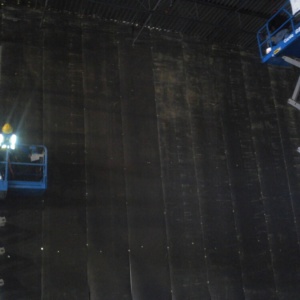One of the most ideal uses for soundproofing membranes is when low-frequency reduction is critical to the performance of a system. This is especially true with entertainment and industrial venues, where low-frequency noise is generated from equipment and amplified speakers.
A recent case study with a luxury cinema in Dallas, Texas serves as a prime example. The client required an STC of 65 for the wall performance, but more importantly, needed attenuation above 20 dB in the 50-80Hz range. This is difficult, if not impossible, to achieve with conventional methods, including multiple layers of drywall on double metal-stud walls.
With gypsum-only assemblies an STC of 65 may be reached, but the attenuation (transmission loss) at 50 Hz is often around 8-12 dBs. Furthermore, this data point is not factored into STC performance, since STC only incorporates performance between 100-4000Hz.
Instead, we worked with the client’s architect to implement a hybrid solution with 1 layer of drywall on each side, and 1 layer of membrane applied directly to the studs behind the drywall. We used the INSUL software to model the system, and determined that this should provide a significant improvement in the low-frequency and broadband attenuation characteristics for the wall.
Once confirmed, we scheduled a test with Riverbank Acoustical Labs to run a custom test for this system, and received the results within 2 weeks. As expected, attenuation at the critical lower frequencies was 60-70% higher than the gypsum-only design. This is primarily due to the resonance of the wall, as the membranes provide a damping of the system while gypsum transmits sound energy through multiple layers if directly attached.
33 foot rolls were custom-produced and delivered to the job site to optimize the installation and maximize schedule recovery. Each roll was hoisted on the scissor lift and attached via 4 screws along the header track of the stud system. The lift was then lowered while the roll unspooled from the lift bar. This allowed the membrane to be installed at 3-4 times the rate of standard drywall.
Cinema Soundproofing Results
The results were excellent – our client received a benefit in each of the cost-schedule-technical legs of the typical construction triad.
Cost: Significantly reduced drywall labor out-paced the increased cost of the soundproofing polymer membrane. Furthermore, the lighter-weight wall allowed further stud spacing, saving further material and labor costs.
Schedule: Since the drywall construction was on the critical path, it was essential to reduce it where possible. The membrane installed in each auditorium in less than 1 day, compared to 2 days for drywall. This allowed significant schedule recovery on the project that had been affected by inclimate weather.
Technical: Low-frequency attenuation was improved by 60-70%, especially in the “problem range” from 50-200 Hz. Furthermore, the STC was improved by 3 points overall. The STC improvement of the wall underscores why Wall Blokker and other soundproofing membranes may be an excellent alternative to Soundbreak and QuietRock, or several layers of drywall.



